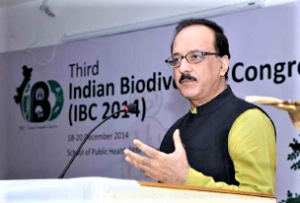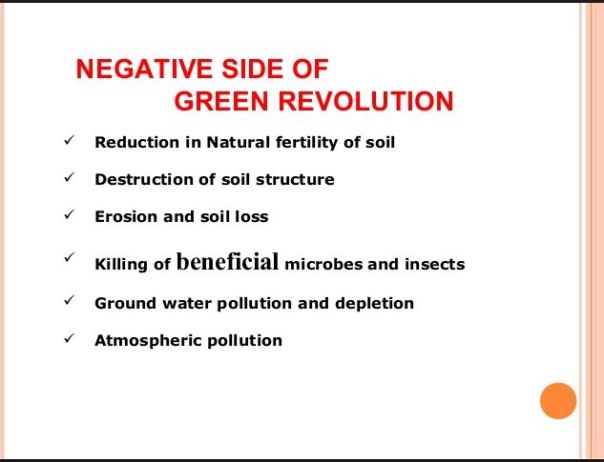Confronting Global Agribusiness: Natural Farming Is the Future
Andhra Pradesh shows the way.

Featured image: Prof. Sharma
The evidence is all there. With soil fertility declining; excessive mining of groundwater sucking aquifers dry; and chemical inputs, including pesticides, becoming extremely pervasive in environment, the entire food chain has been contaminated.
As soils become sick, and erosion takes a heavy toll leading to more desertification, crop productivity is stagnating thereby resulting in more chemicals being pumped to produce the same harvest. A former Director General of Indian Council for Agricultural Research had rightly said:
“In 1980s, farmers used to produce 50Kg of wheat by using 1 kg of fertilisers. Now farmers are producing only 8 Kg by using 1 kg of fertiliser”.
The warning of an ‘Ecological Armageddon’
As farmlands become more toxic, and with modern agriculture becoming a major contributor to Greenhouse Gas Emissions leading to climate aberrations, a startling study has gone unnoticed. A study by the University of Sussex finds that three quarters of flying insects in a nature reserve in Germany have vanished in past 25 years. While the alarming decline in population of honeybees had raised international concerns, that 75% of the insect population has disappeared -even inside a nature reserve – raises the warning of an ‘ecological Armageddon’.
This is happening at a time when not only in Maharashtra, Punjab, Gujarat, and Andhra Pradesh in India, the dreaded bollworm pests on cotton have become resistant to genetically modified cotton in America too. From Carolina to Texas, bollworm insects have renewed their attack on cotton.
The Green Revolution has already run out of steam, leaving behind a trail of misery, the catastrophic consequences manifest in the form of farm suicides. With input costs growing, and farmgate prices remaining almost stagnant, if not declining, farmer’s income is swiftly on the downward slide.

In America, hundreds of dairy farms have closed down in the past 4 years. In Europe, many farms would be unprofitable if European subsidies were to be removed. In France, farmers’ mutual insurance association (MSA) believes that in 2016 “a majority of farmers earned less than Euro 350 a month”.
In India, the government’s own Economic Survey 2016 records that the average income of a farming family in 17 states, which means nearly half the country, has been computed at a paltry Rs 20,000 a year. Another study by Niti Aayog tells that real farm incomes have remained virtually stagnated in the five year period, 2011 to 2016.
And yet more of the same is being pushed as the solution
Despite all the laudable objectives, the world is almost at a tripping point as the International Panel on Climate Change had warned us a few years ago. ‘Business as usual’ is not the right way forward, we are repeatedly told. But despite warning, there is no policy change that actually keeps environment protection as a non-negotiable.
Even the report of the International Assessment for Agricultural Knowledge, Science and Technology for Development (IAASTD), which was ratified during an intergovernmental plenary in Johannesburg, April 7-12, 2008, and had called for a shift towards sustainable agriculture has been lying in limbo ever since.
The more the world tries to change, the more things remain the same. Every disaster is an opportunity. But it invariably ends up as an opportunity for business.
Business leaders from 17 private companies had announced at the 2009 World Economic Forum the launch of a global initiative — New Vision for Agriculture — that sets ambitious targets for increasing food production by 20 percent, decreasing greenhouse gas emissions per ton by 20 percent, and reducing rural poverty by 20 percent every decade.
The 17 agribusiness giants include Archer Daniels Midland, BASF, Bunge Limited, Cargill, Coca-Cola, DuPont, General Mills, Kraft Foods, Metro AG, Monsanto Company, Nestlé, PepsiCo, SABMiller, Syngenta, Unilever, Wal-Mart, and Yara International.
The rhetoric has been the same and the solutions have remained the same too: more aggressive push for industrial agriculture. Just to illustrate, to ensure that the world does not witness a repeat of the 2008 food crisis — when 37 countries faced food riots — the international community has been swift in proposing a roadmap (not one, but a plethora of similar privates-sector driven blueprints).
In these difficult times, it is heartening to see the Chinese President Xi Jinping acknowledging the ecological crisis the world faces.
Addressing the National Congress of the Communist Party in Beijing last October, he acknowledged that
“Any harm we inflict on nature will eventually return to haunt us… this is a reality we have to face,”
and then went to specify in more detail his plans to
“step up efforts to establish a legal and policy framework … that facilitates green, low-carbon, and circular development,” to “promote afforestation,” “strengthen wetland conservation and restoration” and “take tough steps to stop and punish all activities that damage the environment.”
He has called for 21st century to be the beginning of an ‘ecological civilisation’.
Back home, as we get half way through 2018, the script for an ecologically sustainable agriculture, which brings back the smile on the face of farmers, without leaving any scar on the environment, is being rewritten.
Andhra Pradesh has launched a massive programme to promote natural farming.

This programme, Rythu Sadhikara Samstha, aims to bring 5 lakh farmers in all the 13 districts during the period 2017-2022 to adopt natural farming practices (read more here and on their Facebook page). I recently visited a number of villages in Kurnool district to meet some farmers who have moved away from chemical agriculture to natural farming practices.
I was amazed to learn that yields are increasing across all crops
In groundnut, yields have gone up by 35 per cent; Cotton productivity has increased by 11 per cent; Chilli by 34 per cent; brinjal by 69 per cent; and paddy by 10 to 12 per cent. So far, 1.63 lakh farmers have switched to natural farming. If crop productivity can increase without using chemical fertiliser and pesticides; if the net income in the hands of farmers goes up considerably; and if natural farming ushers in a climate resilient agriculture,
I see no reason why other states cannot emulate the pioneering efforts being made by Andhra Pradesh.
*
All images in this article are from the author.

